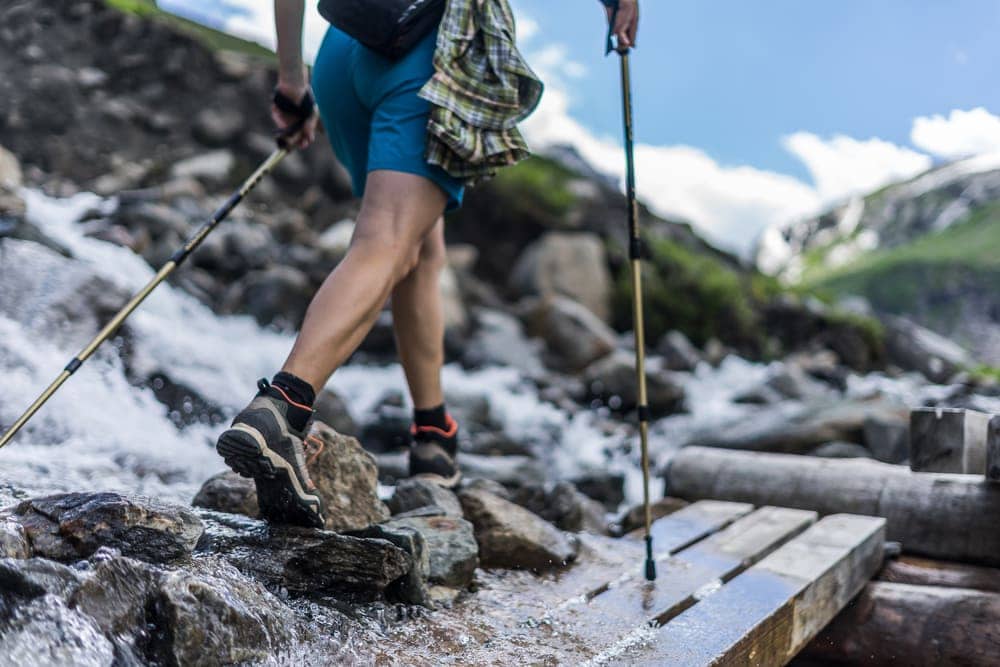
Wondering why you should use trekking poles? Using trekking poles while hiking gives you extra stability and support on tricky terrain. They can also help protect your knees from the wear and tear that comes when you frequently hike downhill. Plus, hiking poles can make you feel more confident as you hike, even when the ground feels slippery underfoot.
The debate over whether you should use trekking poles while hiking is about as old as hiking itself.
Okay, that might be a bit of an exaggeration, but there’s no denying that trekking poles are some of the most controversial pieces of equipment in the hiking community. Most people either love them or hate them, and there are few hikers that will ever change their position on trekking poles, no matter how much you try to argue with them.
But if you’re new to this debate, you might be asking yourself: “Why use trekking poles when I can walk just fine without them?”
In this article, we’ll explore the many benefits of using trekking poles while hiking. We’ll discuss how hiking poles can improve your adventure experience and we’ll investigate the many advantages of being a trusty set of walking sticks with you whenever you head outside.
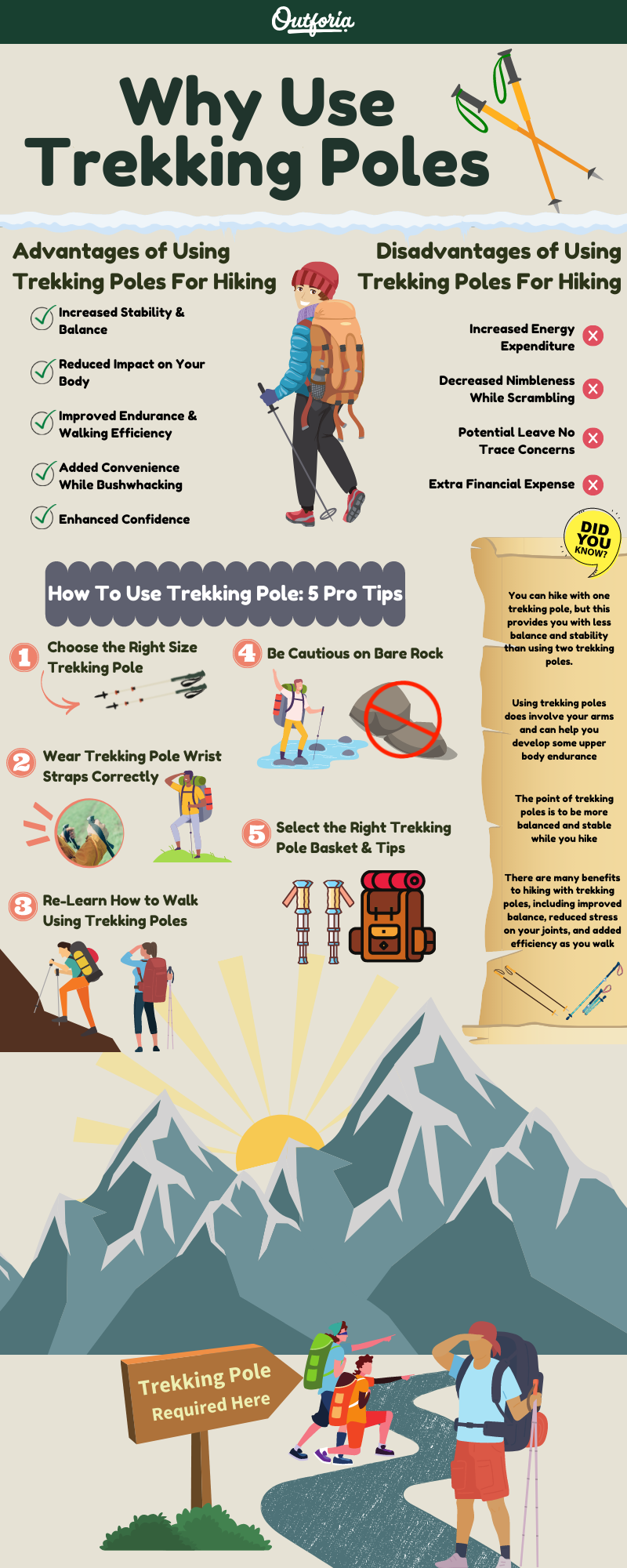
Share This Image On Your Site
<a href="https://outforia.com/why-use-trekking-poles/"><img style="width:100%;" src="https://outforia.com/wp-content/uploads/2022/01/Why-use-trekking-poles-infographics-01032022.png"></a><br>Why use trekking poles Infographic by <a href="https://outforia.com">Outforia</a>Advantages and Disadvantages of Trekking Poles
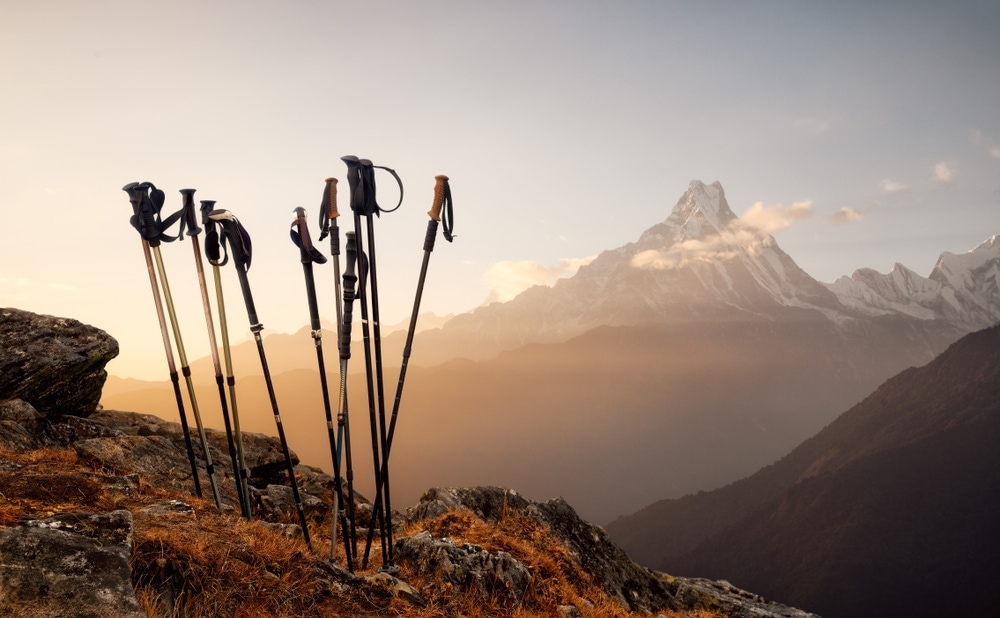
Whether or not you want to use trekking poles while hiking is a completely personal decision. There are plenty of very skilled and experienced hikers that do use trekking poles and many others that don’t.
However, there are many benefits to adding trekking poles to your hiking and camping checklist. Up next, we’ll discuss some notable advantages and disadvantages to using walking poles in the mountains.
5 Advantages of Using Trekking Poles For Hiking
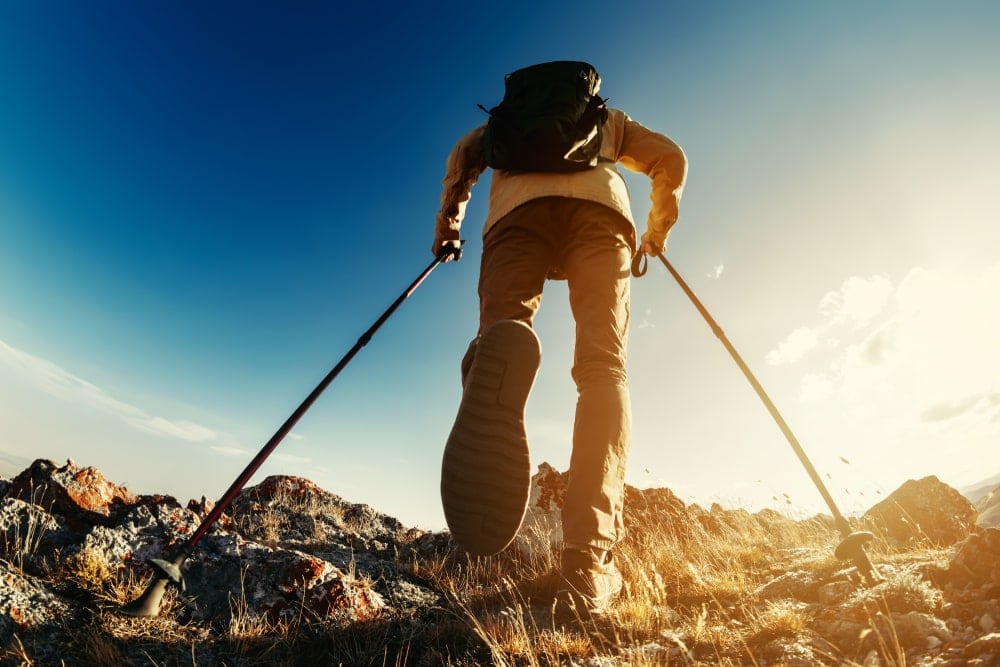
Proponents of trekking poles love to tout the benefits of having two extra points of contact while you hike. But do trekking poles actually live up to the hype?
Some of the biggest benefits you can enjoy when hiking with trekking poles include:
Arguably the greatest advantage of using trekking poles is that they make you more stable as you hike. Those extra two points of contact with the ground can be invaluable on slippery surfaces.
A 2020 review of scientific research on the use of trekking poles even found that they’re particularly helpful for balance instability if you’re carrying a heavy backpack.
Another key benefit of trekking poles is that they can greatly reduce the impact of hiking on your body. When you hike, your ankles, knees, and hips are subject to sizable impact forces every time your foot strikes the ground.
A seminal study from the University of Salzburg even found that using trekking poles can reduce the forces on your knees by up to 25 percent!
When you hike with trekking poles, you include your upper body in what’s normally a lower body pursuit. By doing so, you can use your upper body and your core to help you walk faster without exhausting your legs.
A 2015 study from Oklahoma State University found that using hiking poles can even help reduce your mental perception of how hard you’re working while you hike. In other words, trekking poles help you feel like you’re not exerting yourself as much as you actually are so you can hike for longer without getting mentally fatigued.
If you spend any time hiking off-trail, your trekking poles are an invaluable tool. You can use your trekking poles to move bushes and branches out of the way while bushwhacking so that you don’t have to get hit in the face with flyback whenever you venture off the beaten path.
Of all the benefits of trekking poles, this one is perhaps the most underrated. For many people, hiking poles provide them with enhanced confidence in the mountains. Walking with trekking poles can make people feel more comfortable on tricky terrain.
Feeling comfortable and confident is essential if you’re trying to tackle bigger objectives in the great outdoors.
You May Also Like: If You Have New Boots Then Here Some Tips on How To Break In Your Hiking Boots Fast!
4 Disadvantages of Using Trekking Poles For Hiking
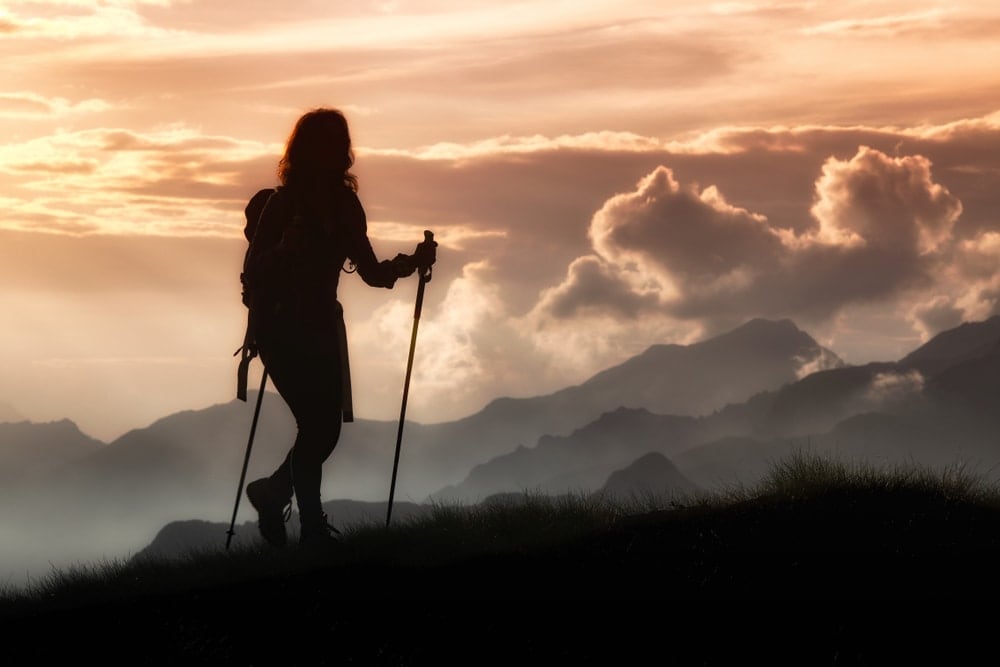
Even though there are many benefits to using trekking poles, there are some notable drawbacks to them, too. Some of the most important disadvantages of using trekking poles to consider include:
Although trekking poles can improve your endurance and walking efficiency, studies have found that they may also increase your overall energy expenditure. This increase in spent energy is likely due to the fact that trekking poles require constant movement from your arms.
But if it makes you feel any better, one study from Poznan University in 2017 also found that using trekking poles can help improve your upper body strength and performance. Who knew?
If you ask hikers that don’t like using trekking poles why they prefer to walk poleless, one of the most common reasons you’ll hear is that walking with hiking poles makes it more difficult for you to use your hands while scrambling.
Indeed, since you generally have to hold hiking poles in your hands, they do make you less nimble in certain situations. That said, you can always strap your poles to your backpack if you know that you’ll need to use your hands to do a bit of scrambling on the trail.
An often overlooked downside to using trekking poles is the damage that they can cause to the environment. The carbine tips found on many hiking poles can leave very clear scratch marks on bare rock and they can destroy fragile plants.
There are certainly ways to reduce your impact when hiking with trekking poles, but this is a critical thing to keep in mind whenever you venture outside.
Trekking poles are just one more piece of gear that you have to buy. Even though there are some budget-friendly trekking poles out there, most are fairly expensive, especially if you want a lightweight model.
You May Also Like: Your Hiking Boots Should Be Comfortable! Learn How Hiking Boots Should Fit with Useful Tips!
How to Use Trekking Poles Like a Pro:
5 Top Tips
Trekking poles might seem like simple pieces of gear, but there are some dos and don’ts that you should abide by when hiking with walking sticks. Here are 5 top tips to help you use trekking poles like a pro.
1. Choose the Right Size Trekking Pole
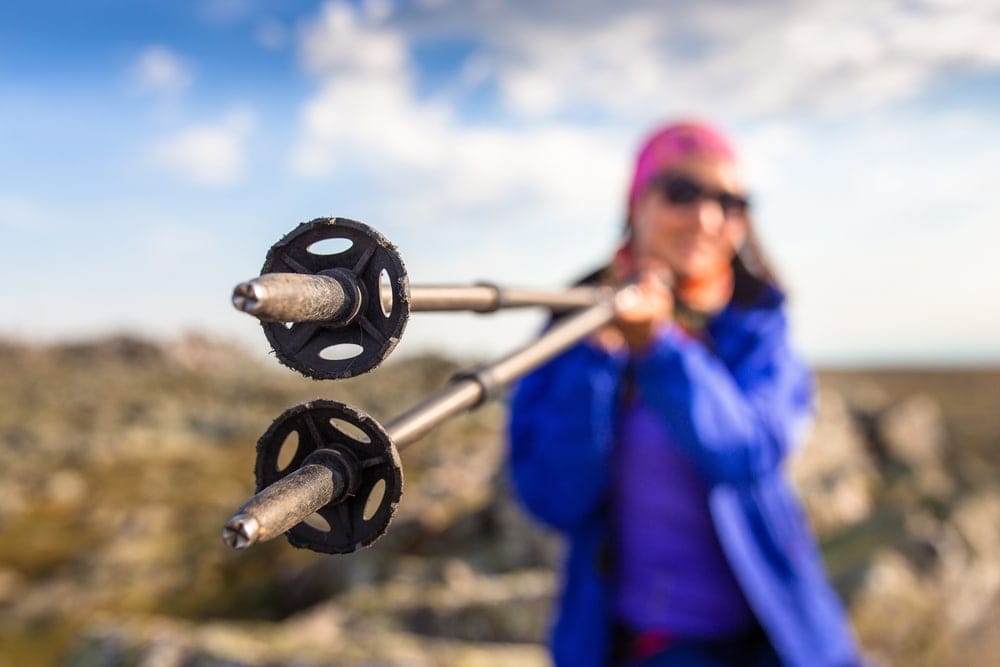
One of the most important things you can do to set yourself up for success with hiking poles is to choose the right size walking sticks for your needs. Walking with poles that are too long or too short can throw off your gait and make you less efficient as you walk.
Today, most hiking poles are adjustable so you can find the perfect fit for your body. Ideally, your trekking poles should be just tall enough that your elbows form a 90-degree angle when you grip the top of the pole while the tip is on the ground next to your feet.
However, every set of adjustable trekking poles has a maximum length that they can accommodate. Extending adjustable poles beyond their stated maximum length can increase the chances that they break while you hike.
As a general rule, hikers that are taller than about 6 feet (183 centimeters) should opt for trekking poles that have a maximum length of at least 51 inches (130 centimeters).
Hikers that are shorter than 6 feet (183 centimeters) can generally use most adjustable hiking poles that are on the market. But it’s still worth testing out a new pair of walking sticks in-store or at home before your first trip to ensure that you have the right poles for your needs.
2. Wear Trekking Pole Wrist Straps Correctly
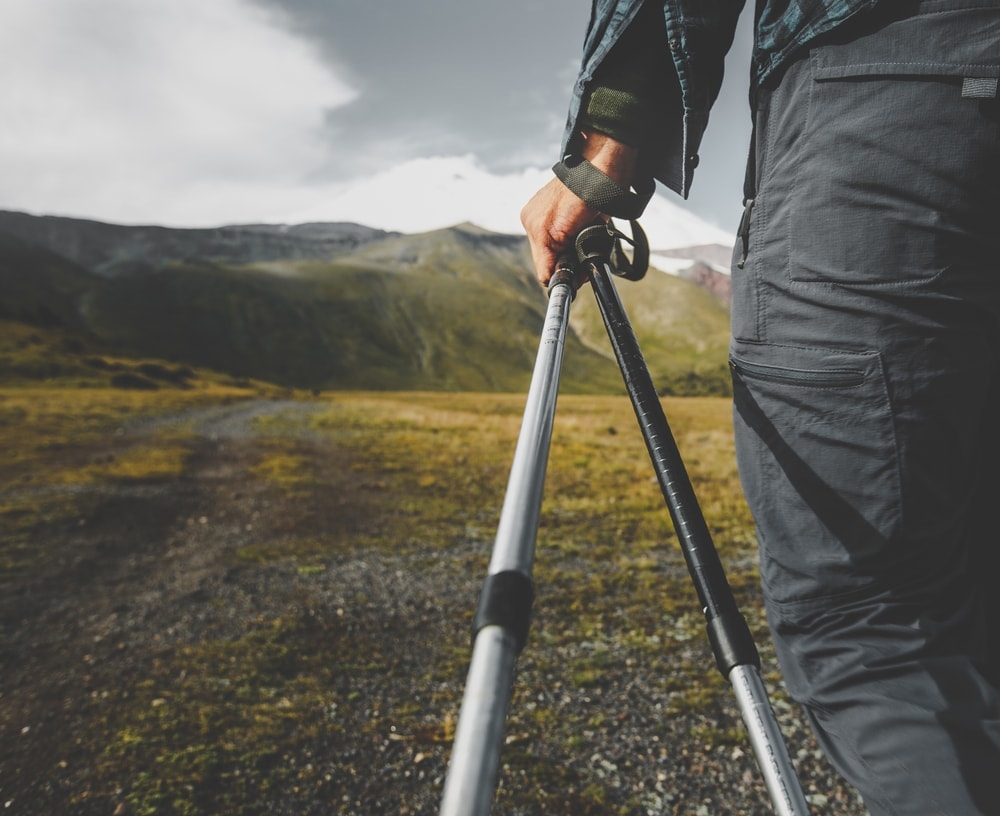
The vast majority of trekking poles that you can buy come with a set of wrist straps that are attached to the upper grip of the pole. These straps are super helpful for reducing grip fatigue after a long day of hiking.
However, most people you see on the trail aren’t using their hiking pole wrist straps correctly. That’s because most people treat their wrist straps as ways to keep their trekking poles attached to their hands. But, in reality, these straps are designed to support your wrists so that you don’t have to grip as tightly on your poles while you hike.
Here’s a quick video that shows you how to use your trekking pole wrist straps correctly:
3. Re-Learn How to Walk Using Trekking Poles
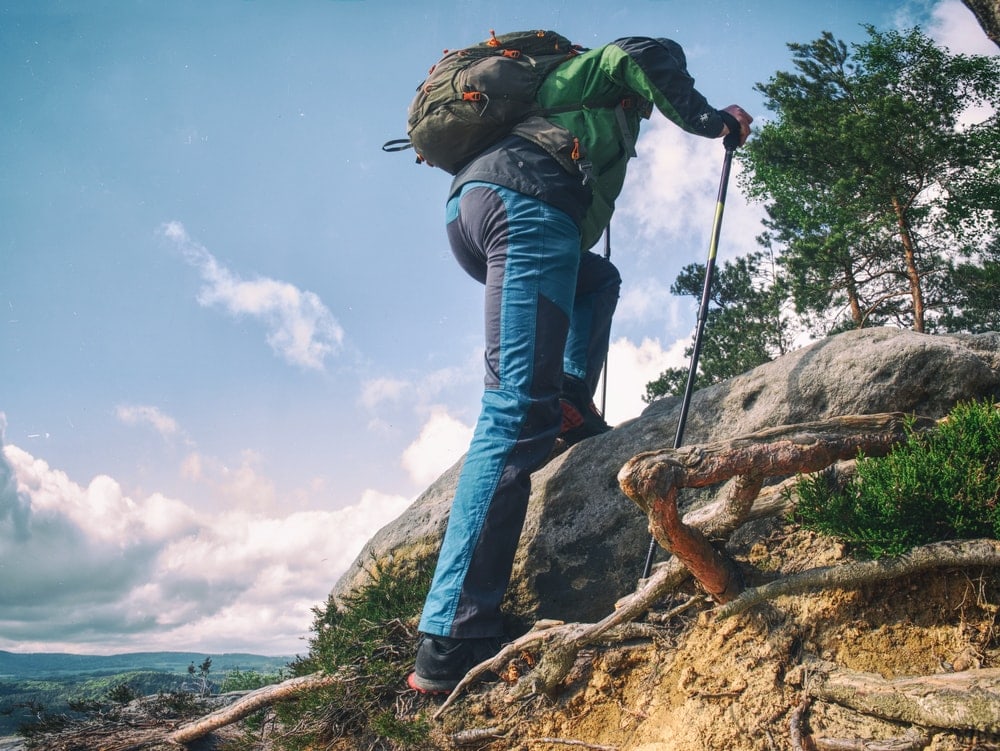
If you’re new to using trekking poles, your very first hike with walking sticks might feel a bit awkward. While most people find that they can quickly adapt to walking with trekking poles, others find that it’s difficult to adjust to a new style of hiking.
One of the most efficient ways to hike uphill with trekking poles is to keep a steady rhythm where you plant the opposing foot and the opposing trekking pole at the same time. In other words, you want to plant your left foot and your right hiking pole at the same time—not your left foot and left pole.
This rhythm is generally the most efficient way to walk uphill with poles because it lets you propel yourself forward using the power of your arms.
But, you may find that it’s easier to do the opposite of this when walking downhill.
Planting your right foot and right pole (or left foot and left pole) at the same time when walking downhill can alleviate some of the pressure on your body as you hike. With this method, you can actually use your trekking pole to absorb some of the shock that would normally reverberate through your foot as you walk downhill.
Regardless of which method you use for hiking with trekking poles, be sure to take things slowly the first few times you venture outside. It takes time to re-learn how to walk with poles, so be patient with yourself as you adapt to your latest piece of gear.
Here’s a quick video that shows you how to use your trekking pole:
4. Be Cautious on Bare Rock
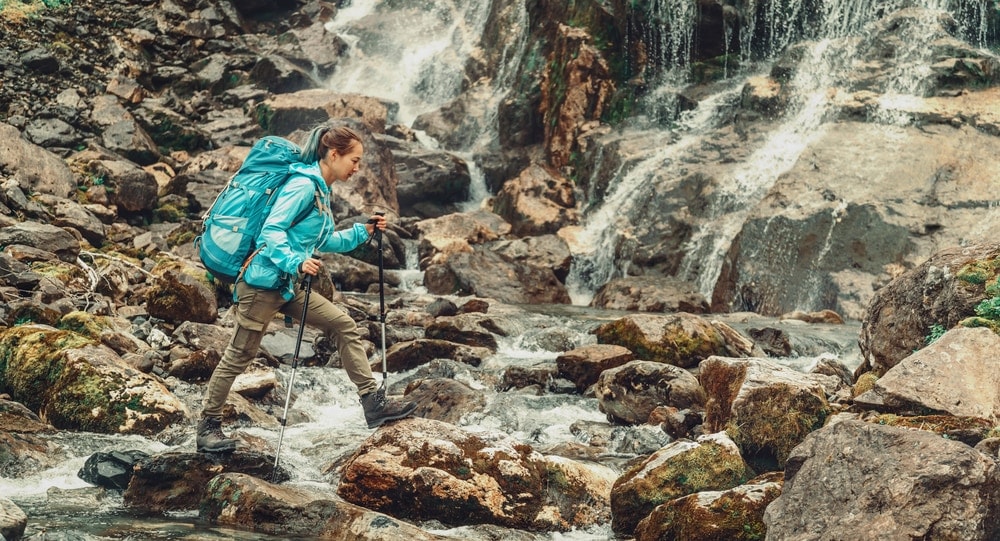
Trekking poles give you lots of extra stability and support as you hike. But in certain situations, you may find that your trekking poles don’t provide as much stability as you might expect.
In particular, be cautious when using trekking poles on bare rock, especially if that rock is wet or sloping.
While your poles might be able to provide you with a bit of extra balance in these situations, you don’t want to overestimate their abilities either. Putting too much pressure on your poles in these situations can cause the tips of your walking sticks to slip out from underneath you—not ideal.
The key here is to have good form when walking downhill, regardless of the terrain that you’re on. Check out this short video to learn more about how to walk downhill properly with your trekking poles:
5. Select the Right Trekking Pole Basket & Tips
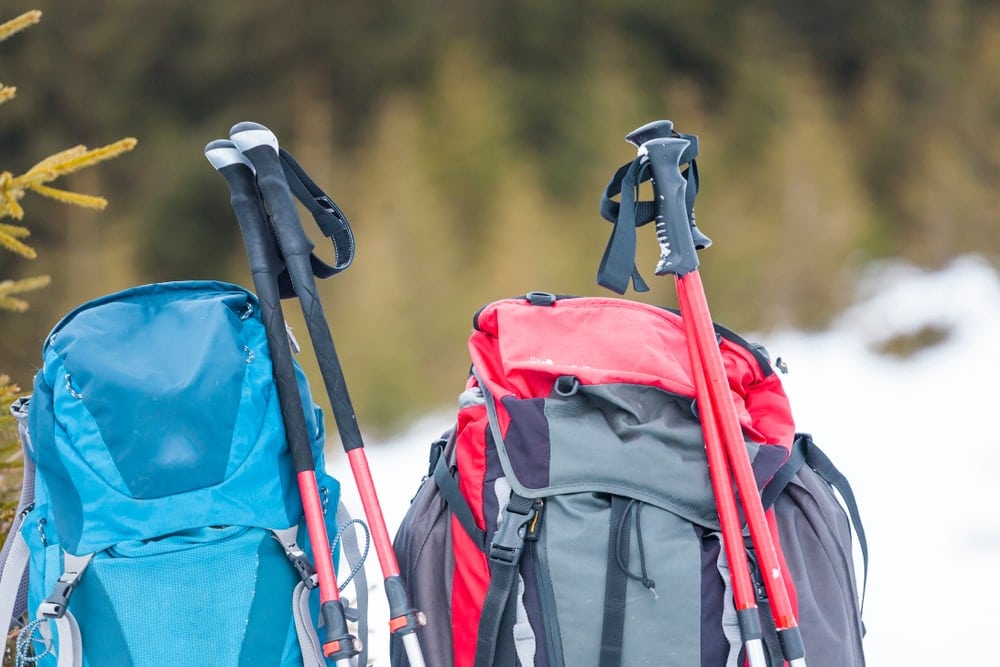
Finally, don’t overlook the importance of selecting the right baskets and tips for your trekking poles.
The baskets and tips on your trekking poles might seem like afterthoughts, but they play an important role in your hiking experience.
There are various kinds of hiking pole baskets out there, each of which is designed for a unique type of environment. The point of having these baskets is to prevent your poles from getting stuck in the mud or in between rocks and debris on the trail. Baskets can also help stop your poles from sinking in soft snow.
You can get different hiking pole baskets for summer and wintertime use at most major outdoor retailers. But keep in mind that not all pole baskets are sized to work on all trekking pole brands. When in doubt, buy baskets from your trekking pole manufacturer to ensure that you get the right model for your needs.
Another key part of any hiking pole is the trekking pole tip.
These tips are your pole’s sole point of contact with the ground, so they’re what gives you traction as you hike. There are two main types of hiking pole tips: rubber and carbide.
Rubber tips are best for use on bare rock as they provide you with extra traction without the potential for creating unsightly scratches on any rock slabs on the trail. Alternatively, carbide tips are best for general use as they’re durable and they can give you traction on mud, hard dirt, and even ice.
No matter which trekking pole baskets and tips that you use, it’s important that you consider your options so that you always have the right gear for the conditions you expect on the trail.
You May Also Like: Explore the Beginner’s Guide for Scrambling in Hiking with Photos, Facts, FAQs, and More!
Hiking Poles FAQs
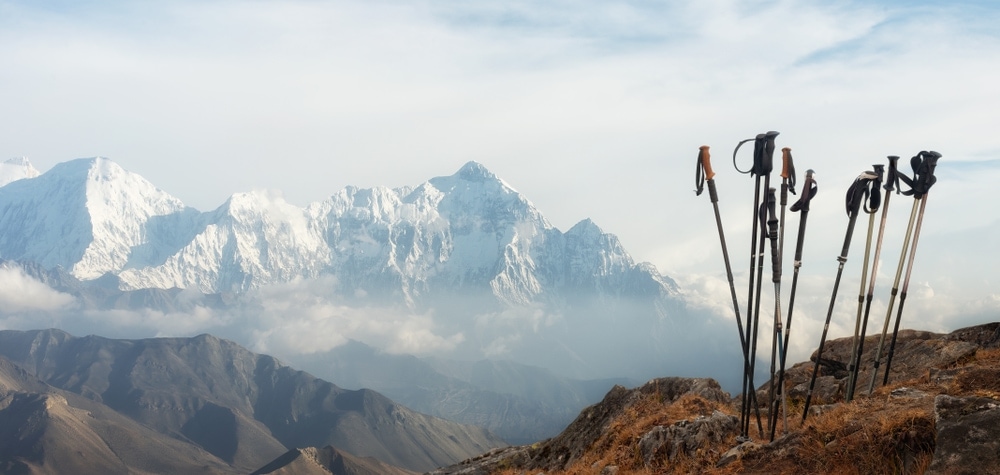
Here are our answers to some of your most commonly asked questions about trekking poles:
Can you hike with one trekking pole?
You can hike with one trekking pole, but this provides you with less balance and stability than using two trekking poles. However, using one trekking pole can sometimes be more versatile, especially if you think you might need a free hand for scrambling or to deal with other obstacles on the trail.
Do trekking poles tone arms?
Using trekking poles does involve your arms and can help you develop some upper body endurance.
But you’re not likely to become a bodybuilder just from hiking with trekking poles, so it’s important to keep your expectations in check whenever you’re working toward a specific training goal.
What is the point of a trekking pole?
The point of trekking poles is to be more balanced and stable while you hike. Using hiking poles can also make you more efficient as you walk and it can help reduce the impact of hiking on your ankles, knees, and hips.
Trekking poles can also give you the confidence you need to seek out more challenging adventures in the mountains.
Do I Need Trekking Poles?
There are many benefits to hiking with trekking poles, including improved balance, reduced stress on your joints, and added efficiency as you walk.
But there are downsides to using hiking poles, too, especially if you spend a lot of time scrambling in the mountains.
At the end of the day, the only person that can decide if you should hike with trekking poles is you. If you’ve never used them before, it’s worth giving walking sticks a shot on your next adventure. But if you’ve tested out hiking poles before and decided that you don’t like them, that’s okay, too.
We hope that this article helped you learn more about the pros, cons, and uses of trekking poles while hiking. See you in the mountains!










